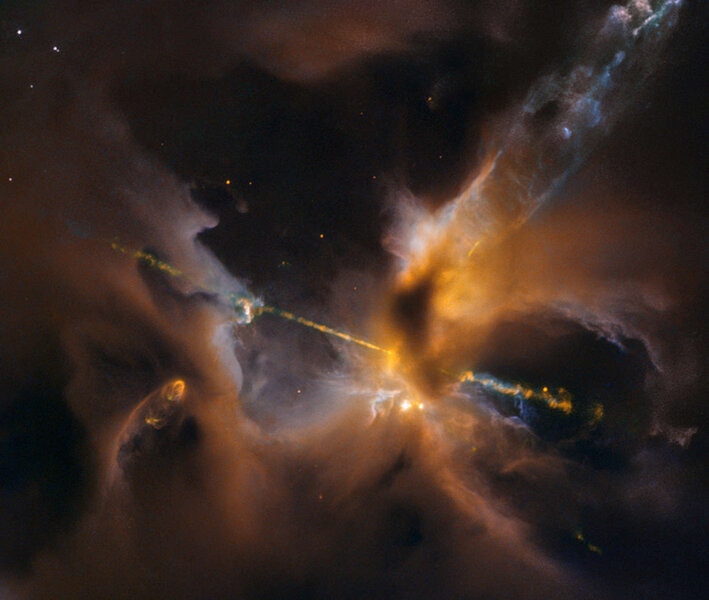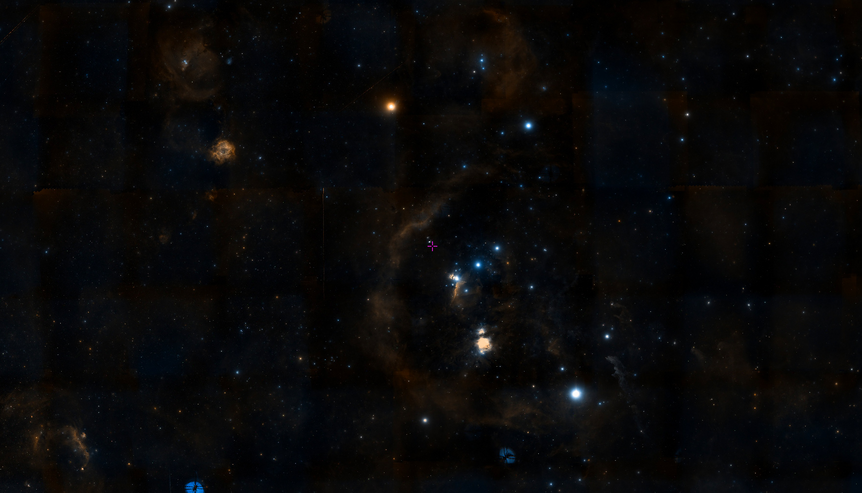Create a free profile to get unlimited access to exclusive videos, sweepstakes, and more!
A baby star stabs through the heart of Orion

You might think of stars as pretty points of light in the night sky. You might even think of the Sun as a star, its presence stable and easy to take for granted.
But a star is a mighty beast; octillions of tons of seething gas, energy, magnetic fields, all powered by a nuclear furnace at its heart.
And when one is born it is not a calm and staid process. It is prone to vast outbursts, powerful enough to dwarf any concept we have of the scale, some blasting out without focus, and some laser-collimated to a fantastic degree.
Such is the case for Herbig-Haro 24 (or just HH 24), a very young star that is announcing its birth by sending out twin beams of energy into the dark.
That Hubble image shows HH 24 and its surrounding environs in the infrared (colors are assigned to different infrared filters used, creating an image our eyes can interpret). Located about 1,400 light years away in the constellation Orion, roughly halfway between the Hunter's iconic Belt and the bright star Betelgeuse on the sky, it's part of a very dense, cold, and dark complex of gas and dust clouds called Orion B. This is a site of active starbirth, the material collapsing to form stars throughout the complex.
The star at the heart of HH 24 isn't visible, hidden still behind thick material between us and it. As the cloud material forming it collapsed, it fell into a disk with the growing star at its center. Embedded in this disk is a strong magnetic field, near the center spun up into a vortex resembling a tornado. The gas in the very center is heated hugely and lifted away from the star in opposite directions, focused by the magnetic vortex. This creates twins beams of matter and energy, what astronomers call jets, blasting away from the star. We call these Herbig-Haro objects, and dozens are known. A similar process occurs with black holes, as well.
In the case of HH 24 they are extremely narrow, and can remain focused for trillions of kilometers. It appears that they have pushed away the surrounding material like a rocket ramming through a cloud, carving out and illuminating vast cavities in the dense material around them.
Knots and clumps in the jets may be due to periods when more material from the star's inner disk was ejected, sent in to the star and then out, slamming into slower material ahead of it, which heats it up and causes it to glow. This makes the jet's overall appearance that of pearls on a string… if the string is a light year long, and the pearls are heated to thousands of degrees.
And HH 24 isn't alone. The huge lobe of material to the upper right appears to surround another jet, probably another HH object embedded in the dust. If you look you can find a few more as well; this area of the sky is renowned for star birth creating jets like these.
Interestingly, the left jet from HH 24 appears to change direction upwards a bit after passing the bright knot of material at the left of the central cavity. That might be coincidence, or it might be hitting dense material there and being deflected. That lobe to the lower left points right at the same place, which indicates to me that another dense clump of material is forming a star embedded there.
HH objects don't last long in the cosmic scheme of things, and sometime in the future the mechanism firing out those jets in HH 24 will shut down, and they'll dissipate. As for the star itself, it will settle down and become a "normal" star, something like the Sun. The disk surrounding it, in part responsible for all that activity, may form planets as well. In a few million years it may look not too unlike our own solar system... implying our own may have looked like HH 24 back in its extreme youth, 4.6 billion years ago.
It's natural to gaze in awe at the beauty of the forces shaping star birth in this image... but reserve some of that awe for ourselves, born in just such a structure, eons ago.





























